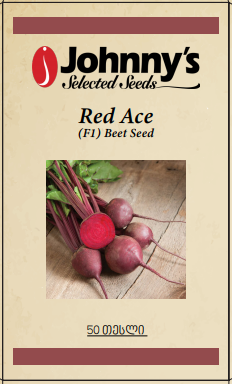Description
Reliable, adaptable, and fast-maturing beet with strong tops. Sweet and tender, even when older. Medium-tall, red-veined greens for bunching. Also available with NOP-compliant pelleting. Avg. 36,800 seeds/lb. Packet: 350 seeds.
SCIENTIFIC NAME:Beta vulgaris
CULTURE:First-rate crops grow quickly in light or loamy soils with a pH over 6.0. In general, cool temperatures produce the best flesh color. Acute weather fluctuations will cause zoning (white rings) in the roots.
TRANSPLANTING:Sow seed in a cold frame or indoors in early spring, about 5-6 weeks before transplanting out after heavy frosts become infrequent. Sow 1/2" deep, 2–3 seeds per cell in 72- or 128-cell flats. Transplant 3" apart in rows 12–18" apart. Beets transplanted using this method may not be as uniform as direct-seeded beets, and taproots will tangle, requiring the harvester to gently pull out the root while holding back the rest. However, transplanted beets can bring earlier harvests if poor weather conditions persist and interfere with direct seeding.
DIRECT SEEDING:Begin early sowings when soil has warmed to 45°F (7°C). Sow 15 seeds/ft. 1/2" deep, rows 12–18" apart. Thin to 1 plant per 3". For a continuous supply of greens and small tender beets, sow seed at 2-week intervals until 8 weeks before regular heavy frosts are expected.
DISEASES:Keep beets well-irrigated to prevent scab, the same disorder that affects potatoes, causing raised brown rough spots on the mature roots. Internal breakdown or browning is most likely to occur in alkaline soils after prolonged hot, dry periods. This is caused by a boron deficiency. Rotate crops to prevent Cercospora leaf spot, which is especially important for bunching and baby-leaf beets.
HARVEST AND STORAGE:Harvest when roots reach desired size, wash, and store bunches up to 10 days at 32°F (0°C) and 95% relative humidity.
SCIENTIFIC NAME:Beta vulgaris
CULTURE:First-rate crops grow quickly in light or loamy soils with a pH over 6.0. In general, cool temperatures produce the best flesh color. Acute weather fluctuations will cause zoning (white rings) in the roots.
TRANSPLANTING:Sow seed in a cold frame or indoors in early spring, about 5-6 weeks before transplanting out after heavy frosts become infrequent. Sow 1/2" deep, 2–3 seeds per cell in 72- or 128-cell flats. Transplant 3" apart in rows 12–18" apart. Beets transplanted using this method may not be as uniform as direct-seeded beets, and taproots will tangle, requiring the harvester to gently pull out the root while holding back the rest. However, transplanted beets can bring earlier harvests if poor weather conditions persist and interfere with direct seeding.
DIRECT SEEDING:Begin early sowings when soil has warmed to 45°F (7°C). Sow 15 seeds/ft. 1/2" deep, rows 12–18" apart. Thin to 1 plant per 3". For a continuous supply of greens and small tender beets, sow seed at 2-week intervals until 8 weeks before regular heavy frosts are expected.
DISEASES:Keep beets well-irrigated to prevent scab, the same disorder that affects potatoes, causing raised brown rough spots on the mature roots. Internal breakdown or browning is most likely to occur in alkaline soils after prolonged hot, dry periods. This is caused by a boron deficiency. Rotate crops to prevent Cercospora leaf spot, which is especially important for bunching and baby-leaf beets.
HARVEST AND STORAGE:Harvest when roots reach desired size, wash, and store bunches up to 10 days at 32°F (0°C) and 95% relative humidity.


